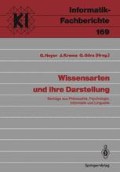Zusammenfassung
Die in der Vergangenheit entworfenen Wissensrepräsentationsparadigmen zur Darstellung von Zeitbezügen zeichnen sich entweder durch mangelnde Ausdruckskraft, oder durch geringe Effizienz aus. Ausgehend von einer Klassifikation der Paradigmen in „zeitachsen-orientierte Ketten“ und „Beziehungsnetze“ wird eine Repräsentation durch „transitive Ketten“ vorgeschlagen, die die Vorteile beider Gruppen unter Ausnutzung der transitiven Eigenschaften einiger temporalen Grundrelationen vereinigt, nämlich die Transparenz und Ökonomie der zeitachsen-orientierten Ketten und die Ausdruckskraft der Beziehungsnetze, ohne dabei auf anwendungsgebietspezifisches Wissen angewiesen zu sein. Weiter wurde ein transitivitätsbasierter Constraint-Propagation-Algorithmus formuliert. Sowohl sein Speicherplatzbedarf wie auch die Rechenzeit weisen eine wesentlich niedrigere Komplexität auf als der Allensche Grundalgorithmus, im Vergleich zu dem Allenschen „Referenzintervallmodell“ bietet die auf transitiven Ketten basierte Representation Vorteile bzgl. Nutzbarkeit für automatische Inferenzsysteme sowie Vollständigkeit der Inferenzen.
Abstract
The paradigms developed in the past for the representation of temporal references have frequently suffered from either insufficient expressiveness or low efficiency. Classifying the paradigms in “time lines” and “relation networks”, a representation through “transitive chains” is proposed, which integrates the strengths of both groups: the transparency and the efficiency of time line chains and the expressiveness of relation networks. It uses transitivity of some of the elementary temporal relations, being independent from the domain-specific knowledge. Further, a transitivity-based constraint propagation algorithm is formulated. Its space requirements as well as computing time are substantially lower than those of J. Allen’s basic algorithm. Moreover, the transitive chain model is superior to Allen’s “reference interval” model in its usability for automatic reasoning and completeness of its inferences.
Access this chapter
Tax calculation will be finalised at checkout
Purchases are for personal use only
Preview
Unable to display preview. Download preview PDF.
Literatur
Allen, J.F., Maintaining knowledge about temporal intervals, CACM 26(11), 1983, 832–843.
Allen, J.F., Towards a general theory of action and time, Artificial Intelligence 23(2), 1984, 123–154.
Allen, J.F., Koomen, J.A., Planning using a temporal world model. Proc. 8th IJCAI, Karlsruhe, 1983, 741–747.
de Kleer, J., Brown, J.S., A qualitative physics based on confluences. Artificial intelligence 24, 1984, 7–83.
Forbus, K.D.Qualitative process theory. Artificial Intelligence 24, 1984, 85–168.
Freksa, C. Intrinsische vs. extrinsische Representation und analoges Schliessen, in this book.
Furbach, U., Wissensrepraesentation und Programmiersprachen, in this book.
Hrycej, T., An efficent algorithm for reasoning about time intervals. Proc. Fachtagung „Expertensysteme ’87“, Nuernberg, April 1987.
Kahn, K., Gorry, G.A., Mechanizing temporal knowledge, Artificial Intelligence 24(1977), 87–108.
McDermott, D., A temporal logic for reasoning about processes and plans. Cognitive Science 6(2), 1982, 101–155.
Riemann, R., Seel, N., Mentale Modelle — Eine Form der analogen Wissensrepraesentation ?, in this book.
Schwind, C.B., Temporal logic in artifical intelligence. Proc. 8th German Workshop on Artificial Intelligence, Wingst/Stade, 1985, 238–264.
Vilain, M.B., Kautz H.. Constraint propagation algorithms for temporal reasoning. Proc AAAI-86, Philadelphia, 1986, 377–382.
Vilain, M.B., A system for reasoning about time. Proc AAAI-82, Pittsburgh, 1982, 197–201.
Voss, H., Representing and analyzing time and causality in HIQUAL models. Memo SEKI-85–07, Fachbereich Informatik, Universitaet Kaiserslautern, 1986.
Editor information
Editors and Affiliations
Rights and permissions
Copyright information
© 1988 Springer-Verlag Berlin Heidelberg
About this chapter
Cite this chapter
Hrycej, T. (1988). Transitivity in Relations Between Time Intervals. In: Heyer, G., Krems, J., Görz, G. (eds) Wissensarten und ihre Darstellung. Informatik-Fachberichte, vol 169. Springer, Berlin, Heidelberg. https://doi.org/10.1007/978-3-642-73533-2_20
Download citation
DOI: https://doi.org/10.1007/978-3-642-73533-2_20
Publisher Name: Springer, Berlin, Heidelberg
Print ISBN: 978-3-540-19071-4
Online ISBN: 978-3-642-73533-2
eBook Packages: Springer Book Archive

